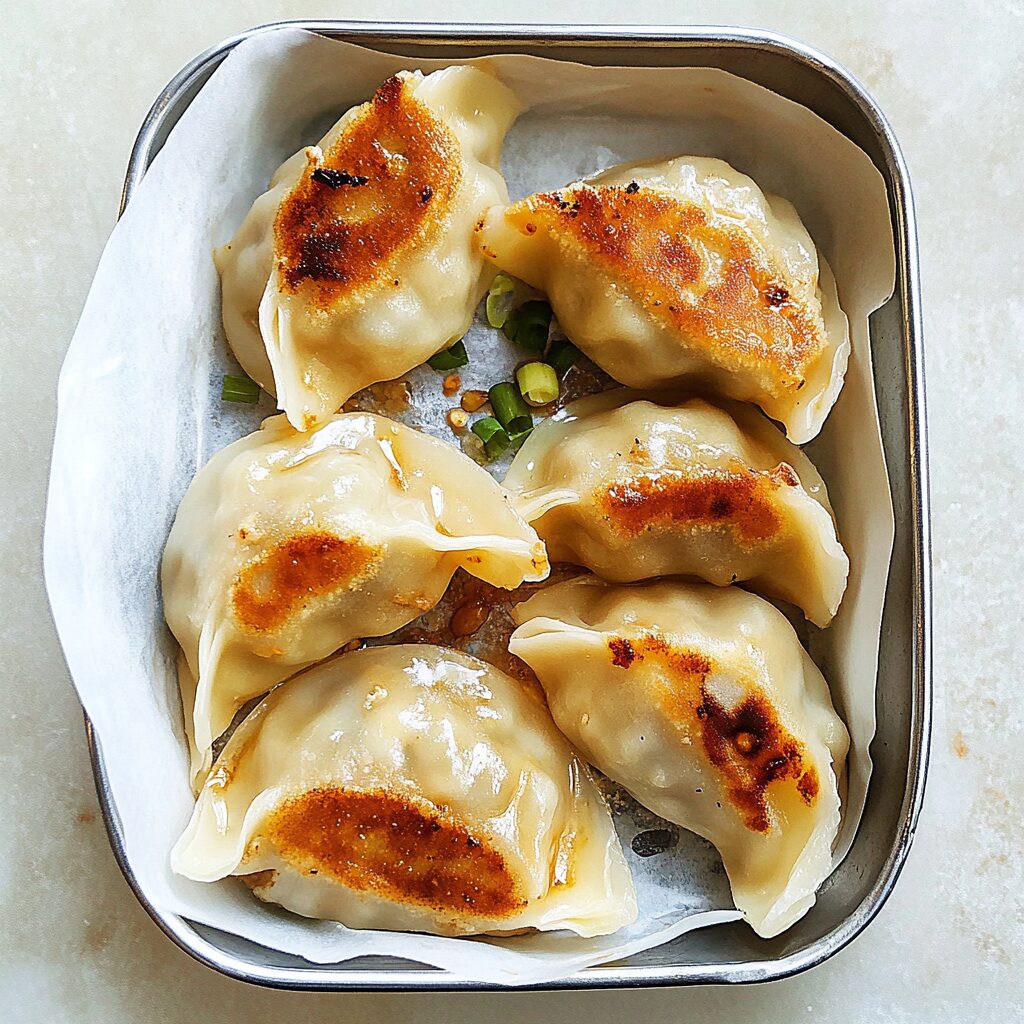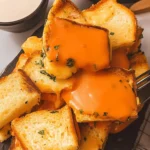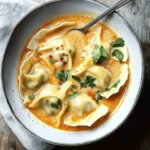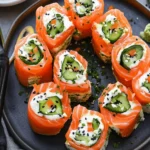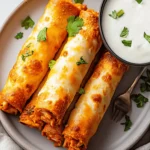Chinese dumplings, or Jiaozi, are a beloved traditional dish, symbolizing family and togetherness. These dumplings come with endless possibilities for fillings and cooking styles, such as boiling, steaming, or pan-frying. They’re perfect for celebrating special occasions or as a delightful appetizer.
FULL RECIPE:
Ingredients
- For the dough:
- 300g (10.5 oz) all-purpose flour
- 150ml (2/3 cup) water
- For the filling:
- 250g (9 oz) ground pork
- 200g (7 oz) Chinese cabbage, finely chopped
- 1 tablespoon light soy sauce
- 1 teaspoon sesame oil
- 1 teaspoon grated ginger
- 1/2 teaspoon white pepper
- 1/2 teaspoon salt
Directions
- Prepare the dough: Gradually mix water into the flour to form a dough. Knead for 8-10 minutes until smooth. Cover and let rest for 30 minutes.
- Prepare the filling: Combine ground pork, cabbage, soy sauce, sesame oil, ginger, white pepper, and salt. Mix well.
- Shape the wrappers: Divide the dough into small pieces and roll each into a thin circle about 8cm in diameter.
- Assemble the dumplings: Place a teaspoon of filling onto the center of each wrapper. Moisten the edges with water, fold, and press to seal, pleating if desired.
- Cook the dumplings:
- Boiling: Cook dumplings in boiling water. Stir gently and let them float before cooking for another 2-3 minutes.
- Steaming: Arrange dumplings in a steamer and steam for 8-10 minutes over medium heat.
- Pan-frying: Fry dumplings flat-side down until golden, then add water, cover, and steam for 5-6 minutes.
- Serve hot with a dipping sauce of soy sauce, black vinegar, and chili oil.
Nutrients (Per Serving)
- Calories: 220 kcal
- Protein: 12g
- Fat: 7g
- Carbohydrates: 27g
Versatility of Chinese Dumplings
One of the most appealing aspects of Chinese dumplings is their versatility. They can be filled with an endless array of ingredients, ranging from classic pork and Chinese cabbage to vegetarian combinations like mushroom and tofu. Dumplings can also be cooked in multiple ways, boiled for a soft and chewy texture, steamed for a delicate bite, or pan-fried for a crispy bottom. This adaptability makes them suitable for various dietary preferences and occasions. Beyond the fillings and cooking methods, dumplings can be served as an appetizer, a main dish, or even as a snack. Their size and portability make them ideal for sharing, creating a communal dining experience that fosters connection and joy among family and friends.
Cultural Significance of Dumplings
Dumplings hold immense cultural significance in China. They are often made and enjoyed during festivals, especially the Lunar New Year, as a symbol of reunion and prosperity. The act of making dumplings is a cherished tradition that brings families together. Each family member takes part in the process, from kneading the dough to wrapping the dumplings, making it an activity that strengthens bonds and creates lasting memories. In addition to their festive role, dumplings are deeply embedded in everyday Chinese life. They are a common comfort food, found in bustling street markets, casual family dinners, and upscale restaurants alike. No matter the setting, dumplings represent warmth, comfort, and the essence of home-cooked meals.
Health and Nutrition
Chinese dumplings can also be tailored to fit various health needs and preferences. The fillings can be customized to include lean meats, fresh vegetables, and herbs, making them a balanced and nutritious meal. Steaming or boiling dumplings is a healthier alternative to frying, reducing the fat content while preserving the natural flavors of the ingredients. Moreover, dumplings are an excellent way to incorporate nutrient-rich foods like ginger, garlic, and Chinese chives, which are known for their health benefits. Ginger aids digestion, garlic boosts the immune system, and Chinese chives are rich in vitamins A and C. These ingredients not only enhance the flavor but also contribute to the overall nutritional value of the dish.
Global Appeal of Chinese Dumplings
While deeply rooted in Chinese culture, dumplings have transcended borders and gained popularity worldwide. Variations of dumplings can be found in many cuisines, each with its own unique twist. Japanese gyoza, Korean mandu, and Polish pierogi are just a few examples of how this simple yet versatile dish has been adapted and embraced by different cultures. In Western countries, Chinese dumplings have become a favorite in both restaurants and home kitchens.
Tips for Making Perfect Dumplings
- Choose fresh ingredients: The quality of the filling ingredients greatly impacts the flavor of the dumplings. Opt for fresh meat and vegetables for the best results.
- Don’t overfill: Adding too much filling can make it difficult to seal the dumpling and may cause it to burst during cooking. A teaspoon of filling is usually sufficient for most dumpling wrappers.
- Seal tightly: Ensure the edges of the wrapper are sealed tightly to prevent the filling from leaking out. Use a little water to help the edges stick together.
- Experiment with pleating: While pleating is optional, it adds a decorative touch to the dumplings. Practice different pleating techniques to find one that works best for you.
- Cook with care: Whether you’re boiling, steaming, or pan-frying, pay close attention to the cooking process to ensure the dumplings are evenly cooked and maintain their texture.
Serving Suggestions
Chinese dumplings are best enjoyed with a dipping sauce that complements their flavors. A classic dipping sauce typically includes soy sauce, black vinegar, and a touch of chili oil for heat. You can also add minced garlic, sesame oil, or sugar to customize the sauce to your liking. For a complete meal, serve dumplings alongside a light soup, such as hot and sour soup or a clear broth with vegetables. They also pair well with a side of stir-fried greens or a fresh cucumber salad for a refreshing contrast. They also pair well with a side of stir-fried greens or a fresh cucumber salad for a refreshing contrast.
Conclusion
Chinese dumplings (Jiaozi/饺子) are much more than a delicious dish—they are a celebration of tradition, culture, and family. Their rich history, versatility, and global appeal make them a beloved favorite among food enthusiasts. With a little practice and creativity, anyone can master the art of dumpling-making and enjoy the rewards of this timeless dish. So, gather your ingredients, invite your loved ones, and embark on a culinary journey that celebrates the essence of Chinese cuisine.

